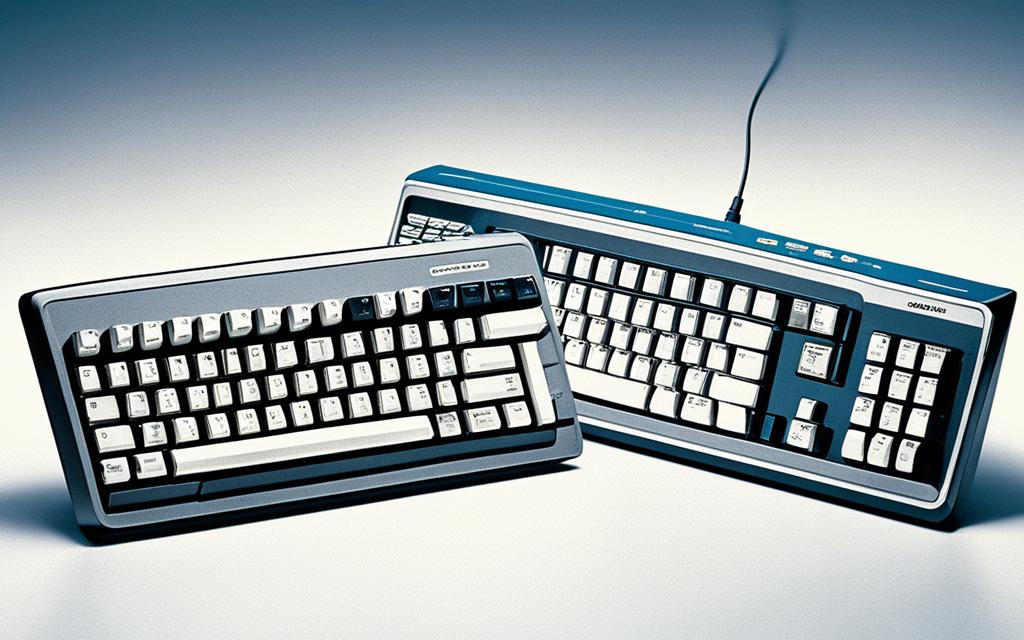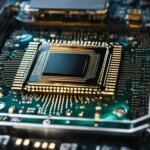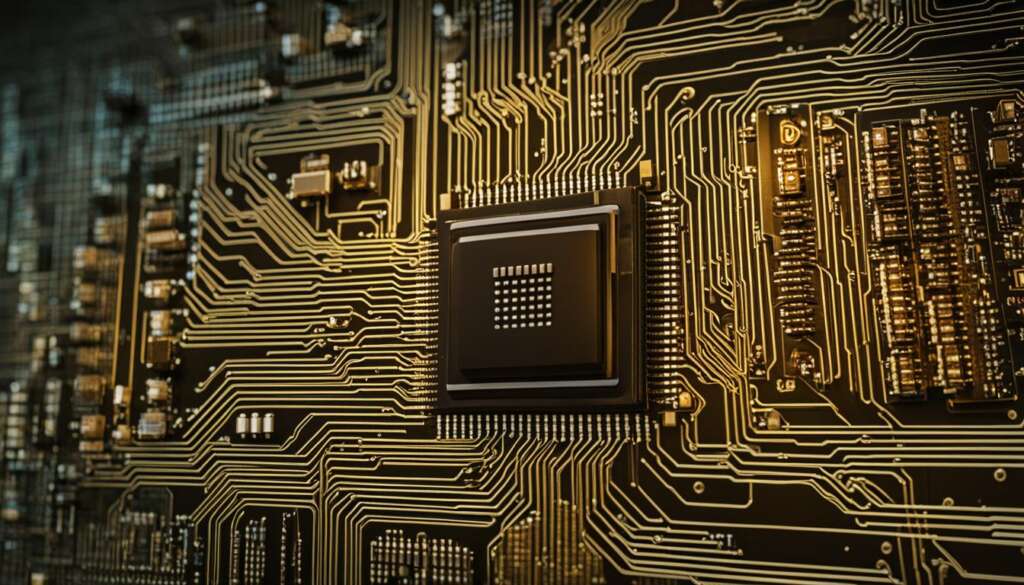Table of Contents
The story of the computer keyboard began with the typewriter’s invention. Christopher Latham Sholes’s patent in 1868 was a pivotal moment. It paved the way for typing technology that has evolved into today’s keyboards. In 1877, the Remington Company started selling these typewriters to many people12.
We explore the connection between early typing devices and modern keyboards. This shows how designs have changed the way we type. The QWERTY layout, introduced in 1878, is still used in Western countries12.
Keyboards have come a long way from electric typewriters to our current digital tools. Each breakthrough has added to the rich history of typing. This journey shows how technology shapes our interaction with devices.
Key Takeaways
- The typewriter, patented by Christopher Latham Sholes, was a precursor to the modern computer keyboard.
- Mass production of typewriters by the Remington Company in 1877 revolutionised typing.
- The QWERTY layout was developed in 1878 and remains dominant in Western countries today.
- Keyboard innovation has included touchscreen, ergonomic, and mechanical designs.
- Technological advancements have significantly enhanced typing efficiency and user experience.
The Evolution of the Typewriter
The story of the typewriter is amazing. It shows human creativity over time. The idea started in the 1700s when inventors wanted to make writing easier. Henry Mill got the first typewriter patent in 1714, an important moment in its history3. The early models were simple and each looked different. This led to key advances in the 1800s.
The First Typewriters: A Glimpse into Early Designs
The first attempts at making typewriters had various designs. In 1829, William Austin Burt made the Typowriter, setting the stage for later ones. Pellegrino Turri’s model in 1808 introduced the Carbon Copy. These early inventors laid the foundation for the typewriter to evolve.
Christopher Latham Sholes’ Contribution
Christopher Latham Sholes played a huge part in the typewriter’s story. He got a patent in 1868 for the first useful typewriter. Known as the Sholes and Glidden typewriter, it was made by Remington in 1877. This was a big leap, making typewriters known to more people4.
The Impact of the Remington Company
The Remington Company made the typewriter popular. Their Sholes and Glidden typewriter was a big hit. It also set up a model for future typewriters. The QWERTY layout, from 1878, is still what we use today4.
Key Developments Leading to the Computer Keyboard
The path to the modern computer keyboard included key moments. The teletype machine was one of these innovations. It changed how we communicate and enter data significantly.
This device was crucial in connecting old typing methods and early computers. It helped bridge two worlds.
Introduction of the Teletype Machine
Early in the 20th century, the teletype machine changed communication. It let users send messages over telegraph lines. This was a big shift from earlier methods.
Its role in early computers was clear. For example, the ENIAC, the first digital computer, used a teletype for entering data. It shows how vital this machine was in the history of computing5.
Keypunch Systems and Their Role in Early Computing
Keypunch systems played a big part in computing growth in the 1930s. They helped enter data into early computers. This was key to developing more advanced technology.
By using these systems, operators could make punched cards. These cards were vital for early computer tasks. They were crucial in interacting with computers like the ENIAC. They helped advance how we process data6.
Integration of Electric Typewriters with Computers
By the late 1940s, electric typewriters began to merge with computers. This blend improved data entry and made typing easier. Electric typewriters became very popular, especially IBM’s models.
They were easier to use and influenced current keyboard designs. Their design was a big step towards the keyboards we use today. They answered the needs of many users7
The QWERTY Layout and Its Significance
The QWERTY layout, invented in the 19th century, has deeply influenced how we use technology. Christopher Latham Sholes developed it in the early 1870s. He wanted to stop jams in mechanical typewriters by spacing out commonly used keys. First made in large numbers in 1874, the QWERTY design has been key in technology, winning the hearts of people and professionals89.
The Origins of the QWERTY Layout
Sholes’ idea took a lot of trial and error before it worked well. He then worked with James Densmore, and together, they sold the typewriter design to E. Remington and Sons. The Remington No. 2, launched in 1878, made the QWERTY layout popular, becoming a big moment in typing history910. This layout wasn’t just practical. It also became familiar to users, securing its place in typing.
Alternative Keyboard Layouts: Dvorak and Others
In 1932, August Dvorak created an alternative aiming for better efficiency and speed. Studies showed Dvorak users typed faster and more accurately than those using QWERTY10. Despite these benefits, the Dvorak layout hasn’t become widely used. This is partly because QWERTY keyboards are already well-established and available to most users.
Modern Usage and Acceptance of QWERTY
The QWERTY layout is everywhere today, on both hardware and touchscreen devices. It’s seen on smartphones and tablets where virtual keyboards are essential. Its wide recognition makes it the go-to choice for many, while Dvorak and other layouts stay more obscure810. The QWERTY design continues to shape how we communicate with technology every day.\p>
The History of Computer Keyboard: Innovations and Changes
The story of computer keyboards is all about big tech leaps. Each step, from video display terminals to today’s electronic keyboards, changed how we use computers. Each innovation made typing and processing info easier and faster.
Development of Video Display Terminals
Video display terminals, or VDTs, changed how we interact with computers. They started in the 1960s, thanks to MIT and Bell Labs. VDTs let users see what they typed in real-time, mixing the best of both worlds – seeing and typing. This was a big deal, making it much easier to work with computers.
The Transition to Electronic Keyboards
Later, we moved from mechanical to electronic keyboards. This shift in the late 20th century made typing quicker and more reliable. With electronic keyboards, we got more options and better designs, fitting what users needed. These keyboards also introduced special features like hot-swappable switches. They became essential in both homes and offices, thanks to a control processor that boosted performance and let users tailor their experience11.
Evolutions During the 1990s: Handheld Devices and PDAs
The 1990s brought us handheld gadgets, changing how we think about keyboards. PDAs, with their compact sizes and touchscreens, made it easy to type on the go with tiny QWERTY keyboards. This step showed how flexible keyboard design could be. It also opened the door to the mobile tech we use today.
| Innovation | Year | Description |
|---|---|---|
| Video Display Terminals | 1960s | Real-time visual feedback for typing, enhancing editing processes. |
| Electronic Keyboards | Late 20th century | Transition to electronic mechanisms improved speed and efficiency. |
| Handheld Devices (PDAs) | 1990s | Compact designs with QWERTY layouts and touchscreens for data entry. |
Conclusion
Looking back, the journey from early typewriters to modern keyboards has been amazing. Major milestones in the keyboard evolution have changed how we interact with technology. The QWERTY layout started by Christopher Latham Sholes in 1868 was a big step. Then came the IBM Model F keyboard in 1981, and ergonomic designs. These changes have made typing easier and more accessible, meeting the needs of many users. They show the importance of adapting intyping technology.
Looking ahead, the way we use keyboards is changing. Now, we have voice recognition and soft keyboards. These new trends could change how we talk to our devices. Also, more keyboards now have extra keys for media and are built for gaming. This shows we’re always looking for ways to type better and have fun doing it. Plus, smart keyboards that predict what you’ll type next could make typing even easier.
In wrapping up, how keyboards have changed tells us a lot about our past and how we work and share information today. With constant new inventions and a focus on comfort, the future of keyboards is exciting. It’s as ever-changing as the path that got us here, keeping keyboards vital in our daily routines. Exploring these new developments is important. We must remember the big changes that have set the stage for future innovations in the world of141516.
FAQ
What is the history of the computer keyboard?
The story of the computer keyboard starts in the 1700s. It began with the invention of the typewriter. Christopher Latham Sholes’ patent in 1868 led to the first mass-produced typewriter. This was a key step towards the keyboards we use today.
Who invented the QWERTY layout?
Christopher Latham Sholes and James Densmore created the QWERTY layout in 1878. They arranged letters to stop typewriters from jamming. This made typing more efficient.
What role did electric typewriters play in keyboard evolution?
Electric typewriters, appearing in the late 1940s, changed data entry hugely. They made typing faster and more comfortable. They also helped merge typewriter and computer designs, shaping today’s computer keyboards.
How did video display terminals change typing methods?
In the 1960s, video display terminals (VDTs) arrived. They let users see their work as they typed. This made editing easier and helped people type better, improving keyboard usability.
What innovations occurred in keyboard technology during the 1990s?
The 1990s brought new keyboard designs. Key among these were handheld devices like Personal Digital Assistants (PDAs). They offered compact keyboards and touch screens. This changed how we enter data and interact with devices.
Are there alternative keyboard layouts besides QWERTY?
Yes, the Dvorak Simplified Keyboard is an alternative to QWERTY. Created in 1936, it aims to speed up typing and reduce finger movement. However, QWERTY remains popular due to its widespread use in the English-speaking world.
What is the future of keyboard technology?
Keyboard technology is moving towards more innovations. Future highlights include soft keyboards, voice recognition, and other advances. These will improve accessibility and the way we use digital devices.
Source Links
- https://keyboardkeytest.com/blogs/evolution-of-keyboards – Evolution of keyboards
- https://theinventors.org/library/inventors/blcomputer_keyboard.htm – The History of the Computer Keyboard
- https://www.daskeyboard.com/blog/typing-through-time-the-history-of-the-keyboard/ – Typing Through Time: Keyboard History – Das Keyboard Mechanical Keyboard Blog
- https://www.thoughtco.com/history-of-the-computer-keyboard-1991402 – The History of the Computer Keyboard
- https://www.computerhope.com/issues/ch001802.htm – When Was the First Keyboard Invented?
- https://www.linkedin.com/pulse/evolution-keyboard-73-years-jaspal-khalsa – Evolution of the Keyboard 73 years
- https://mishpacha.com/history-of-the-keyboard/ – History of the Keyboard – Mishpacha Magazine
- https://www.techtarget.com/whatis/definition/QWERTY-keyboard – What is the QWERTY keyboard? – TechTarget Definition
- https://en.wikipedia.org/wiki/QWERTY – QWERTY
- https://www.smithsonianmag.com/arts-culture/fact-of-fiction-the-legend-of-the-qwerty-keyboard-49863249/ – Fact of Fiction? The Legend of the QWERTY Keyboard
- https://en.wikipedia.org/wiki/Keyboard_technology – Keyboard technology
- https://medium.com/@georgetzanetakis/a-grateful-history-of-the-keyboard-4d520dd32426 – A grateful history of the keyboard
- https://www.livescience.com/20718-computer-history.html – History of computers: A brief timeline
- https://medium.com/@HistoricInnovations/a-short-history-of-the-qwerty-keyboard-1597bc7567e0 – A Short History of the QWERTY Keyboard
- https://scilifestyle.com/the-history-of-the-computer-keyboard/ – The history of computer keyboard | Scilifestyle
- https://www.keyboardingonline.com/the-history-of-the-modern-keyboard/ – The History of the Modern Keyboard – Keyboarding Online








